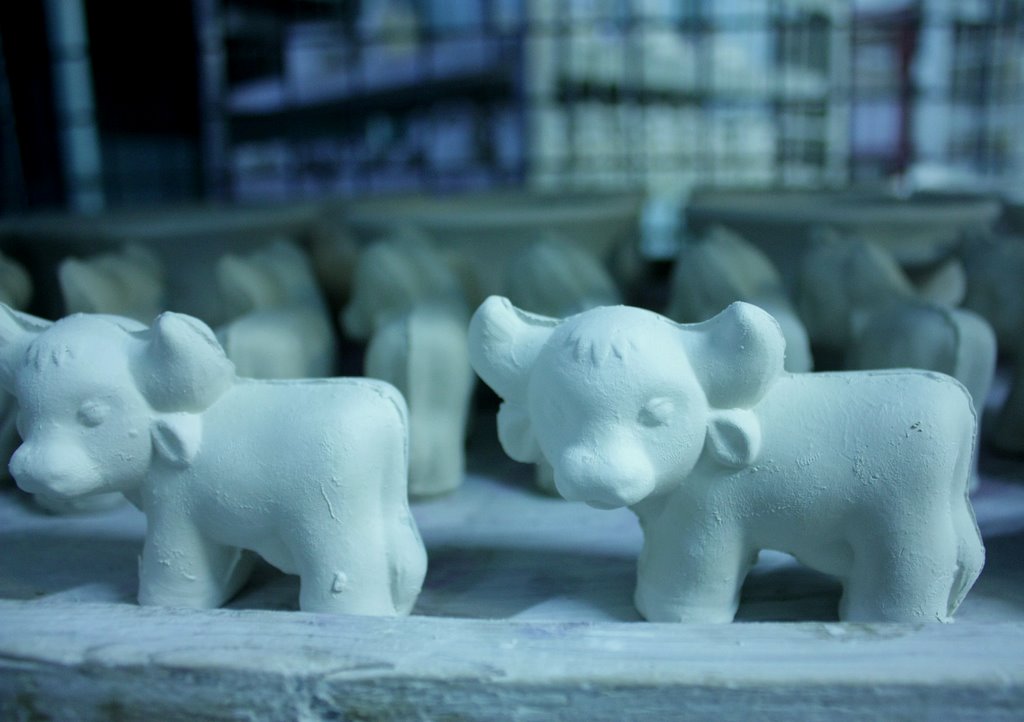Gzhel
It seems that Gzhel’s china ware is the most famous folk craft of Moscow region. Currently Gzhel’s porcelain is made as factory way as domestic way. It interesting, that there is no village that named Gzhel. There are some villages all along Egoryevskoye highway and they forms Gzhel.
The factory is situated in Novokharitonovo settlement. The shop and museum are inside of the fabric building. Here is excursions on production places.
You need call to museum some day before to arrange visiting time. Guide will choose an appropriate time (so that there is no groups). When we arrived only a porter was here. Than another couple got here. Fabric and museum isn’t in a good state. There was cold inside of the building in April.
Early in Ghel was first class deposit of white sea kaolin. The famous russian scientist Lomonosov even cried whe he saw a sample because he never so such clean kaolin before. Immediately a tsar order to stay cordons here and all kaolin went for producing medical ware. Now the deposit is worked out and clay goes from Ukraine.
Before Lenin’s revolution a peasants made china and toys in this place. Gzhel belong to the Imperial cort and this territory was free from serfdom. There is a legend that at 19 century a very rich tatar man went to Moscow via Gzhel. He decided to stay in home of one peasant. The surname of last was Kuznetsov. Nobody saw that rich man after this. At first people thought that peasant kill him, but Kuznetsov said that tatar man left his home early morning and if people isn’t believe to him they could to conduct a search. The search wasn’t find anything. But some years after this case Kuznetsov bought equipment and open the factory. Some years after his son became the Porcelain Emperor of Russia. Almost all china factories in Podmoskovye was founded by him.
Business grew and Kuznetsov became the supplier of the Emperor court. His descendants put the quality of china to the world highest standards with help of foreign engineers. About 1914 one of this engineers wanted to have a share of factory. But owner wasn’t agree. The engineer decide to move to Nizhniy Novgorod but lost. The technology was lost with this engineer and nobody know how to produce china with so good gilding. After revolution Kuznetsov presents their factories to Soviet and died soon. Gzhel factory started to produce a propaganda china. Guide said about this with some disregard. Because the quality of this dishes was far from Emperor porcelain. But in London’s auctions these propoganda plates is sold by 4000 pounds.
Before WWII a china wasn’t only blue. But after the war there was a problems with paint. Only cobalt paint could be found easy. Blue chine got Grand Prix in Paris. The factory management decided that it’s a good sign and they started to produce blue things par excellence.
The green set was made for first russian president Boris Yeltsin. This set for many guests, there are 44 things for each person. All valuable stuff is made in two instances. The second instance are stored on factory as spare.
I like a multicolour china.
Manufacture
This is a molding shop. A mixture (a future chine) pour into the forms and leave for hardening. Extending on a potter’s wheel almost haven’t usage nowadays.
The perfect Russian dolls will become from this workpieces.
Uncutted bull-calf. A seam is cutted from hardened moulds and the place of seam is rubbed by a sponge.
After this steps moulds are placed on palletes and putted into the owens. The firer serves an owen. This is a very important job. If firer place one piece on side of the owen and next in the center then during the fire process they will shrink differently and work will broken.
Currently this department is using German ovens with Soviet electronic circuitry. German ovens not so big and it couldn’t be used for glazing of big pieces, so Ghel’s factory doesn’t produce big products at this days. The temperature in the oven could reach 4 000 degree Celsius (7200 F). After glazing the item reduced by 17% and become very strong after several glazings. Various add-ons used to make china ever more stronger. For example, bones of animals are added in bone china.
The ready form “Dachnitsy”
After glazing a miniature is placed into a coloured water. It’s simplified process of searching of defects – a various cracks. The ingredients of coloured agent is completely vanish after last glazing. After that an artist start to paint a miniature.
Painters haven’t any art education, but they must have taste of art. Skilled painter could paint some dozens of cups, plates etc. per day. During the painting a paint looks grey and pattern don’t looking good. A true beauty will come only after final glazing.
This is the brand of true Gzhel.
A painted miniature is plunged into a glaze. A glaze is also clay and it totally harmless, so piece are plunged here just by hands. The worker attempts to oil a bottom of piece by paraffin. This procedure are required not to get slip-proof bottom but to prevent our cow to stick on pallet.
After final glazing an item goes to customers.

















